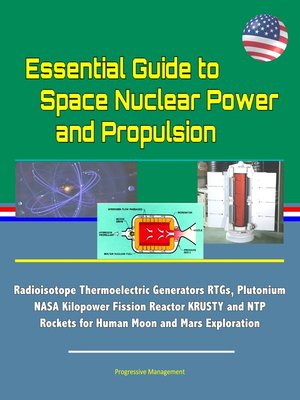Essential Guide to Space Nuclear Power and Propulsion
ebook ∣ Radioisotope Thermoelectric Generators RTGs, Plutonium, NASA Kilopower Fission Reactor KRUSTY and NTP Rockets for Human Moon and Mars Exploration

Sign up to save your library
With an OverDrive account, you can save your favorite libraries for at-a-glance information about availability. Find out more about OverDrive accounts.
Find this title in Libby, the library reading app by OverDrive.



Search for a digital library with this title
Title found at these libraries:
| Library Name | Distance |
|---|---|
| Loading... |
Professionally converted for accurate flowing-text e-book format reproduction, this unique book reproduces important government documents, reports, and studies dealing with spaceflight nuclear power and propulsion technologies, including Radioisotope Thermoelectric Generators (RTGs), Plutonium-238 production, NASA Kilopower Fission Reactor (KRUSTY) and nuclear thermal propulsion (NTP) rockets for human Moon and Mars exploration.
Contents include: Overview of Space Radioisotope Power Systems and RTGs * Advanced Radioisotope Power System Concepts and Designs * Energy Department and Plutonium Production * Space Exploration - DOE Could Improve Planning and Communication Related to Plutonium-238 and Radioisotope Power Systems Production Challenges * Nuclear Thermal Propulsion (NTP) * NASA's Kilopower Fission Reactor Program and KRUSTY
Radioisotope Thermoelectric Generators, or RTGs, provide electrical power for spacecraft by converting the heat generated by the decay of plutonium-238 (Pu-238) fuel into electricity using devices called thermocouples. Since they have no moving parts that can fail or wear out, RTGs have historically been viewed as a highly reliable power option. Thermocouples have been used in RTGs for a total combined time of over 300 years, and a not a single thermocouple has ever ceased producing power. Thermocouples are common in everyday items that must monitor or regulate their temperature, such as air conditioners, refrigerators and medical thermometers. The principle of a thermocouple involves two plates, each made of a different metal that conducts electricity. Joining these two plates to form a closed electrical circuit while keeping the two junctions at different temperatures produces an electric current. Each of these pairs of junctions forms an individual thermocouple. In an RTG, the radioisotope fuel heats one of these junctions while the other junction remains unheated and is cooled by the space environment or a planetary atmosphere.
Benefits of NTP propulsion include: For human Mars missions, first generation NTP can reduce crew time away from earth from greater than 900 days to less than 500 days while still allowing ample time for surface exploration; reduce crew exposure to space radiation, microgravity, other hazards; can enable abort modes not available with other architectures including the potential to return to earth anytime within 3 months of earth departure burn, also to return immediately upon arrival at Mars; and stage/habitat optimized for use with NTP could further reduce crew exposure to cosmic rays and provide shielding against any conceivable solar flare.







